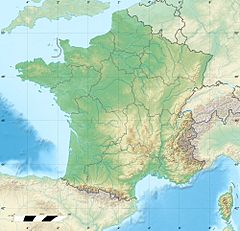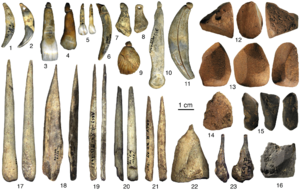Grotte du Renne facts for kids
 |
|
| Location | caves of Arcy-sur-Cure |
|---|---|
| Region | France |
| Coordinates | 47°36′13″N 3°44′27″E / 47.60361°N 3.74083°E |
| Type | limestone karst cave complex |
| History | |
| Periods | late Upper Paleolithic |
| Cultures | Châtelperronian |
| Associated with | Neanderthal |
The Grotte du Renne is a famous cave in France. Its name means "Reindeer's Cave" in French. It's part of a group of caves at Arcy-sur-Cure. This place is an important archaeological site from the Stone Age. Scientists study it to learn about ancient humans.
The cave holds tools and bones from the Middle and Upper Paleolithic periods. These periods were tens of thousands of years ago. Inside, researchers found items made by Neanderthals. They also found Neanderthal bones. Some of the items, like ornaments, suggest Neanderthals had complex behaviors. This idea is still debated by scientists.
Contents
Exploring the Ancient Cave Site
The Grotte du Renne is like a layered cake of history. It has 15 different archaeological levels. These layers go down about 4 meters (13 feet) deep. Each layer tells a story about different times. Scientists label them from I (top) to XV (bottom).
Layers of Time and Tools
The upper layers, IV, V, and VI, contain tools from the Gravettian culture. This culture existed about 34,000 to 24,000 years ago. Level VII shows tools from the Aurignacian culture. This culture was active from about 43,000 to 28,000 years ago.
Levels VIII, IX, and X are from the Châtelperronian culture. This period was around 42,000 years ago. Level X is very special. It holds symbolic ornaments, like pierced animal teeth. There are also ivory pendants and tools called awls. These items are thought to be part of the Châtelperronian culture. In 2023, scientists reported finding 76 Neanderthal fossils in level X. These fossils were found during digs in 1949, 1963, and 1976.
Deeper layers, XI and XII, contain tools from the Mousterian culture. These tools often have jagged edges. The very bottom layer, XIV, shows typical old Mousterian tools.
Animal Life in the Cave
Scientists also found bones of animals in the cave. These include reindeer and horse bones. These animals were important to the people living there. Their bones were used to make tools. Some mammoth remains were also found. One idea was that these remains might have been part of huts. However, this idea has not been proven.
Neanderthal Behavior and Ornaments
The Grotte du Renne is famous because of the items found with Neanderthal remains. These items include personal ornaments. This suggests that Neanderthals might have had complex behaviors. These behaviors are often linked to modern humans. For example, wearing jewelry or making art.
Scientists have debated if Neanderthals truly made these ornaments. Some researchers thought the ornaments might have fallen into the Neanderthal layers from later human layers. This would mean the Neanderthals didn't make them. However, other scientists disagree. They argue that the items and Neanderthal bones are truly linked. They believe the evidence from Grotte du Renne shows Neanderthals were more advanced than once thought. Similar findings at other sites in Europe also support this idea.
Images for kids




